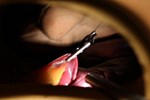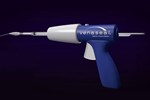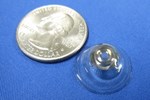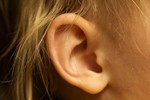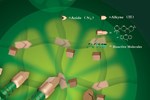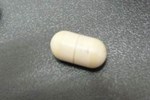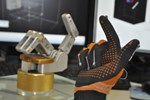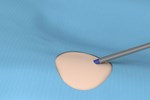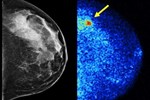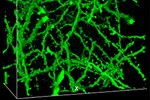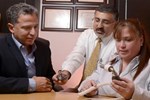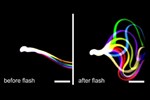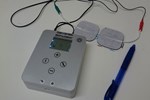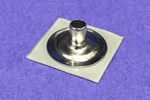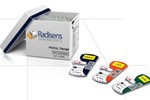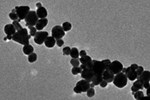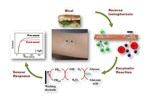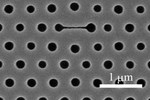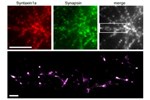ARTICLES BY CHUCK SEEGERT
-
Liquid Biopsy Offers Less-Invasive Diagnosis Of Colorectal Cancer3/10/2015
Researchers in Singapore have developed a new liquid biopsy approach. Designed to specifically detect colorectal cancer in its early stages, the new diagnostic technique promises to enable a personalized approach to cancer treatment without invasive tissue biopsies.
-
Flower-Like Magnetic Nanoparticles Could Improve Cancer Treatment3/5/2015
Researchers at the Dartmouth Center of Nanotechnology Excellence have developed flower-shaped magnetic nanoparticles that are highly sensitive to magnetic fields. This increased sensitivity may enable hyperthermic treatment of deeper, harder-to-reach tumors.
-
Using Magnets To Steer Instruments In Single-Incision Surgery3/4/2015
Using a novel application of magnetic force, researchers from Vanderbilt University have developed minimally invasive surgical instruments that could be more effective and easier to use than current technology. By passing magnetic fields through tissue, the instruments can be operated without being physically manipulated, which could reduce the incisions required and improve function.
-
Researchers Optically Stimulate The Brain To Control Pain3/3/2015
By optically stimulating the anterior cingulate cortex in mice, researchers at the University of Texas at Arlington (UT Arlington) were recently able to dampen the animals’ sense of pain.
-
Paper-Based Test Diagnoses Ebola, Other Fevers In 10 Minutes3/2/2015
Using multicolored silver nanoparticles, a team from the Massachusetts Institute of Technology (MIT) recently developed a diagnostic device that can simultaneously test for several hemorrhagic fevers.
-
Bionic Reconstruction Enables 3 Men To Replace Nonfunctioning Hands2/27/2015
Three Austrian men were the first to undergo a new “bionic reconstruction” procedure, which enabled them to use mind-controlled prosthetic hands. The patients all suffered from brachial plexus injury, which has been called an “inner neurological amputation” because it completely separates the hand from its owner’s control.
-
Could 3D-Printed Guides Enable Personalized Nerve Regeneration Therapy?2/26/2015
Using 3D printed nerve guidance conduits, University of Sheffield researchers have succeeded in helping nerves to repair themselves in vivo.
-
FDA Clears Medtronic's VenaSeal Closure System For Varicose Veins2/24/2015
A new approach to permanently seal superficial varicose veins has recently been approved by the FDA. Using cyanoacrylate adhesive, Medtronic’s Venaseal closure system is a minimally invasive approach that can be performed in an office or outpatient setting.
-
MIT Researchers Develop Self-Healing, Injectable Nanogel2/24/2015
To eliminate the need for open surgical implantation, researchers from the Massachusetts Institute of Technology (MIT) have developed a new injectable nanogel.
-
Pancreas-In-A-Capsule Enters Clinical Trials2/23/2015
One of the few devices in the United States based on embryonic stem cell technology has recently moved into clinical trials. Viacyte, a startup company in San Diego, has used its tissue engineered pancreatic replacement technology to reverse diabetes in animals, an advance that is now being tested in human clinical trials. A successful trial could lead to relief for many millions of people suffering from diabetes.
-
A Wink-Activated Telescopic Contact Lens System To Treat Vision Loss2/20/2015
Researchers from the Swiss institute of technology École Polytechnique Fédérale de Lausanne (EPFL) have developed a revolutionary contact lens with telescopic properties.
-
Could Brainstem Implants Restore Hearing To Deaf Children?2/19/2015
A team led by researchers at the University of Southern California’s (USC’s) Keck School of Medicine recently reported positive results from an ongoing clinical trial that could help children with severe hearing impairment. The study is evaluating the use of a new auditory brainstem implant (ABI) technology in children born without auditory nerves. The study, supported by the NIH, is slated to last three years and has already begun to enroll patients.
-
New Laser System Could Enable Automated Skin Cancer Surgery2/18/2015
A team from Florida Atlantic University (FAU) has developed a novel approach to identifying and removing cancer — while leaving the healthy tissues behind. The technique combines a CO2 laser to ablates skin cancer cells with a Raman spectrometer to distinguish between cancer and healthy tissues with high accuracy, enabling surgeons to determine when the cancer has been completely ablated.
-
Gold Nanotubes Deliver Three-In-One Cancer Diagnostics, Treatments2/18/2015
Researchers at the University of Leeds have developed a new theranostic tool that promises to aid in the fight against cancer. Composed of gold nanotubes that have been tailored to interact with infrared light, the treatment approach enables infrared imaging of tumors that have ingested the particles.
-
Pediatric Artificial Pancreas Under Development2/16/2015
High stress and sleepless nights are common among parents with diabetic children, but a new research program focused on a pediatric artificial pancreas could make that a thing of the past.
-
DARPA Funds Development Of Next-Generation Prosthetics2/12/2015
As part of its new Hand Proprioception and Touch Interfaces (HAPTIX) program, DARPA has selected several research initiatives for funding awards. The goal of HAPTIX is to develop prosthetic limbs that feel and function like natural limbs for amputees — veterans in particular.
-
New Smart Watch Alerts Caregivers To Potential Seizures In Epilepsy Patients2/10/2015
A recently developed smart watch technology can detect movements indicative of a convulsive seizure in people suffering from epilepsy, and provide alerts to parents or other caregivers.
-
Using Electricity To Deliver Cancer Treatment And Spare Healthy Tissue2/9/2015
A team of researchers from Virginia Polytechnic Institute and State University (Virginia Tech) have developed a novel cancer treatment device that delivers high concentrations of medications to tumors while minimizing systemic toxicity. Using electric fields, the new approach drives therapeutics deep into target areas, which would not normally be attainable by systemic methods.
-
“Click” Polymers Could Repair Arteries, Rebuild Tissue, And Deliver Drugs2/6/2015
Novel polymers developed using “click chemistry” show promise in applications ranging from connective tissue replacement materials to drug releasing nanoparticles.
-
3D Printed Heart Makes Surgery Faster, Safer For Children2/4/2015
When planning the repair of a complicated congenital heart defect, surgeons from the Children’s Hospital of Los Angeles recently turned to 3D printing. Using a life-sized 3D model created from the patient’s magnetic resonance imaging (MRI) data, the surgical team was able to shorten the length of the surgery, while also eliminating the need for multiple surgeries that otherwise would have been required.
-
New Bacteria-Repelling Bioadhesive Could Lower Implant Rejection Rates2/3/2015
The likelihood of implant success could be increased through the use of a new, bacteria-repelling coating. Inhibiting bacterial attachment to implants enables the body’s healthy cells to “win the race” to bond to the implant’s surface.
-
Vibrating Capsule May Relieve Chronic Constipation2/2/2015
Patients may soon swallow a vibrating capsule instead of taking laxatives to treat constipation.
-
Fusing MRI And Ultrasound Could Improve Cancer Diagnostics1/30/2015
Using a new combination of magnetic resonance imaging (MRI) and ultrasound, researchers from the University of Maryland have developed a more accurate diagnostic method for detecting prostate cancer. The dual imaging approach guides prostate biopsy collection in a way that is much more effective than standard biopsy methods. Distinguishing between high-risk and low-risk cancers may now be much more straightforward, enabling a more personalized treatment approach.
-
Robotic Hands Develop Better Motor Skills1/29/2015
Researchers from the German Primate Center have recently developed a way to predict hand movements by measuring neuronal activity. Studies performed with a subfamily of primates called macaques have identified the neural activity involved in many hand grasping movements, which is knowledge that could be applied to controlling robotic prostheses.
-
Portable X-Ray Services Are On The Rise1/29/2015
Instead of waiting at an emergency room to be examined, many patients are now opting to have X-rays taken in their homes. Especially convenient for the elderly or patients with significant illnesses, portable X-ray machines can take as little as 20 minutes and may even be able to digitally transmit information to a radiologist.
-
Paper Clip-Sized Implant Reduces High Blood Pressure1/28/2015
Patients with uncontrolled high blood pressure may have a new option thanks to researchers from Queen Mary University in London and ROX Medical. The newly developed implant was able to significantly lower blood pressure in patients — even when several other treatment options had failed.
-
New Imaging Tech Nearly Quadruples Breast Cancer Detection In Dense Tissue1/28/2015
Mayo Clinic researchers have developed a new method that nearly quadruples the detection rates of invasive breast cancers in dense breast tissue. The technique is called molecular breast imaging, and it could supplement existing mammograms with only minimal increases in radiation exposure.
-
Handheld CT Scanner-Like Device Could Provide Alternatives For Eye Exams1/27/2015
Diagnosing eye conditions in pediatric patients may have become slightly easier thanks to recent research from the Baylor Visual Function Testing Center. Their new, non-invasive technology tests for optical diseases by operating like a handheld computed tomography (CT) scanner for the eye. The device accurately performs retinal diagnoses without getting too close to the young patient, who may have difficulty sitting still.
-
High-Tech Hydrogel Helps Promote Blood Vessel Healing1/27/2015
Using a new high-tech hydrogel, Rice University researchers have developed a way to improve wound healing. The new hydrogel can be injected into a wound where it assists in healing and enhances vascular growth. The material slowly degrades and is eventually replaced by natural tissue.
-
Diaper Material Could Help Expand Tissue Imaging1/25/2015
By modifying a superabsorbent material commonly found in baby diapers, researchers from the Massachusetts Institute of Technology (MIT) were able to expand the structure of brain specimens by up to four and a half times their normal size. The new technique is called expansion microscopy, and it enables common microscopes to achieve a “super-resolution.”
-
Improving Clinical Trials Remains Top FDA Priority1/25/2015
To address concerns about lengthy approval times for clinical trials, the FDA has re-committed itself to strengthening and streamlining the complex process. Improving clinical trials is reportedly one of the top three strategic priorities of the FDA’s Center for Devices and Radiological Health (CDRH) for 2015.
-
Could Ventricular Assist Devices Help Cure Heart Failure?1/23/2015
Recent cutting-edge research has shown that left ventricular assist devices may help regenerate heart tissue. Prolonged use of these devices cuts down on certain forms of oxidative cell damage, enabling significant cardiac cell proliferation in humans.
-
FDA Releases Draft Guidance On Medical Device Accessories1/23/2015
The FDA has recently released draft guidance related to medical device accessories, which includes how those products are defined. Classification of these devices uses a risk-based framework, and the guidance describes the process for identifying where an accessory fits within that framework. The document was only released to elicit comments from industry and other parties, and is not final or in effect at this time.
-
Immobile Sperm Cells Swim Again Thanks To Light1/22/2015
For the first time, the function of sperm has been controlled by optogenetic processes. By inserting a light-activated enzyme into mouse sperm, researchers from the Max Planck Society turned previously sterile mice into fertile ones. This work illustrates how optogenetics can be used outside the area of neuronal cell research.
-
Portable Stimulator Could Improve Balance, Motor Skills Of Parkinson's Patients1/22/2015
New research has shown that a small electronic unit may help restore balance to patients suffering from Parkinson’s disease by applying electric noise stimulation. The device provides electrical stimulation to the organs that monitor balance, which compensates for shortages of dopamine and restores motor skills and balance. Originally tried in rats, the technique has now shown some benefit in humans.
-
New Laser Could Significantly Improve Biomedical Imaging1/22/2015
Yale researchers have developed a new semiconductor laser that could advance imaging quality across a broad range of applications. Designed around chaotic cavity laser activity, the device eliminates image corruption. It provides the brightness of traditional lasers and the low image corruption of light-emitting diodes, which could enable next-generation microscopes, photolithography, and biomedical imaging.
-
Wearable Sensor Could Provide Long-Term EKG, EMG Monitoring1/22/2015
A new wearable sensor based on silver nanowires has been developed by North Carolina State University researchers. The sensors are designed to monitor electrophysiological signals and could be used to monitor electrocardiographs (EKGs) and electromyographs (EMGs) — even when a patient is in motion.
-
FDA Releases Draft Guidance On General Wellness Products1/21/2015
The FDA recently released draft guidance related to products that promote a healthy lifestyle. The guidelines were released to clarify what low-risk devices fit into the category of “general wellness products.” The document was only released to elicit comments, and is not final or in effect at this time.
-
“Clinic-In-A-Box” Could Provide Rapid Diagnoses1/20/2015
With a single drop of blood and a few minutes time, a new diagnostic system could detect a wide range of diseases. The “clinic-in-a-box” combines immunoassays, clinical chemistry, and more into a single diagnostic platform that could be used while a patient waits in the doctor’s office. Developed by an Irish company called Radisens Diagnostics, the test is also being looked at by the European Space Agency.
-
J&J To Publicly Release Clinical Trial Data On Medical Devices, Diagnostics1/20/2015
Johnson and Johnson recently revealed plans to systematically make its medical device and diagnostic test clinical trial data available to the public, making it the first large medical device manufacturer to undertake this level of transparency. The healthcare giant will work with Yale University’s Open Data Access program.
-
Can Gold Nanoparticles Help Predict Heart Attacks?1/20/2015
Engineers from the NYU Polytechnic School of Engineering, in collaboration with Peking University researchers, have been developing a new, more sensitive test strip for a biomarker common in heart attack victims. The team created a new fabrication approach that makes colloidal gold nanoparticles with an increased sensitivity for this biomarker, which could provide early detection for heart attacks.
-
3D Facial Imaging May Help Diagnose Autism Earlier1/17/2015
Earlier diagnosis of childhood autism may now be possible using 3D facial imaging. A new method developed by researchers from the University of Missouri uses software algorithms to find trends in the facial features of autistic patients. They discovered that certain features seem to be characteristic of autism, which may allow for more effective treatments to begin earlier.
-
Tattoo-Based Sensor Monitors Glucose Levels Without Finger Pricks1/17/2015
An ultra-thin, flexible device has been developed by researchers to detect a person’s blood glucose levels. The device eliminates the need for the finger pricks often used by diabetics, and it works like a temporary, rub-on tattoo.
-
Web-Based TAVR Marketing Understates Risks, Overstates Benefits1/16/2015
Transcatheter aortic valve replacement is much less invasive than open heart surgery, but like most procedures, it comes with risks. A recent study, however, shows that hospital web marketing for the procedure often fails to accurately convey these risks. In many cases, risk information was even left out, which may be doing patients a disservice.
-
Nanolaser Biosensor Performs Low-Cost, Label-Free DNA Detection1/16/2015
A straightforward imaging method that eliminates the need for fluorescent labels may soon be available. The new approach developed by Yokohama University researchers could be used to detect DNA or proteins related to cancer by measuring changes in the laser’s wavelength and gauging its intensity when molecules are adsorbed in the system.
-
Functional Tissue-Engineered Intestine Grown Using Human Cells1/15/2015
Taking stem cells normally found in the small intestine, researchers grew a tissue-engineered version that replicates many of the functions seen in normal intestinal tissue. The Children’s Hospital Los Angeles team was able to show that the new tissue contained mucosal lining, supported structures, and had the ability to absorb nutrients. Eventually, it may help children with intestines that have been congenitally malformed.
-
“Nanoscopic” Imaging Technique Captures Neurotransmission On Camera1/15/2015
A new breakthrough from Heriot-Watt University may provide significant insight into neurodegenerative diseases like schizophrenia and epilepsy. A new imaging technique has enabled researchers to capture the exact point and time that information is transferred during neurotransmission. Their research is focused on understanding synaptic events, which are often implicated in neurodegenerative diseases.
-
Solar-Powered “Diagnostics-In-A-Suitcase” Developed For Ebola Testing1/14/2015
To deal with extreme field conditions, researchers have developed a self-contained diagnostics laboratory in a suitcase. Designed to perform Ebola testing, the diagnostic platform uses solar power and room temperature reactions to provide results in as little as 15 minutes.
-
Neural Implants Could Provide New Therapies For Paralysis1/14/2015
A recently developed neural implant may offer new therapies for paralyzed patients. The device is an electronic and chemical interface that has been designed for long-term close-contact with the spinal cord or brain. By matching certain properties of the brain, the implant could reduce inflammation and scar tissues that have been problematic in the past.
-
Patient Leaves Hospital Without A Human Heart1/14/2015
Thanks to a backpack-sized power supply, surgeons at the University of Michigan Frankel Cardiovascular Center sent a patient waiting for a heart transplant back home. Cardiac surgeons implanted a total artificial heart powered by a portable driver, allowing the patient to return home without receiving a transplant.



